2. 中国科学院长沙农业环境观测研究站, 长沙 410125;
3. 中国科学院大学资源与环境学院, 北京 100049
2. Changsha Research Station for Agricultural & Environmental Monitoring, Institute of Subtropical Agriculture, Chinese Academy of Sciences, Changsha 410125, China;
3. College of Resources and Environment, University of Chinese Academy of Sciences, Beijing 100049, China
氨气是大气中含量最高的碱性气体, 主要来源于农田施氮肥及畜禽粪便产生的氨挥发[1, 2].大气中的氨(NH3)可与酸性气体(H2SO4、HNO3、HCl等)反应, 形成(NH4)2SO4、NH4HSO4、NH4NO3和NH4Cl等含铵盐的二次气溶胶颗粒物, 这些颗粒物可占到PM2.5和PM10(分别为空气动力学直径小于2.5 μm和10 μm的大气颗粒物)质量的30%~50%[3, 4], 对空气质量、人体健康和太阳辐射有重要的影响, 且能随大气环流进行长距离迁移而对远离排放源的地方产生影响.
存在于大气中氨和气溶胶态铵盐可通过干湿沉降返回地表, 是大气沉降氮素的主要组分, 其沉降量通常可占到氮沉降总量的50%以上[5, 6].近30年来, 随着我国氮肥使用量及畜禽养殖规模的不断提高, 排放到大气中的氨气逐年增多[5].有研究表明, 与20世纪60年代相比本世纪初我国平均氨/铵沉降量增加了5.6倍[7].从空间格局上看, 我国华北地区、东南地区、西南地区氨/铵浓度及沉降量均较高, 大体呈现由东南到西北递减趋势[7, 8].过多的氮沉降将引起水体富营养化、土壤酸化、土壤及水体N2O排放增加、生物多样性减少等多种不良生态环境效应.因此, 氨是一种对人体健康和生态环境都有重要影响的气体.
我国亚热带区域是我国工业、农业以及交通业均十分发达的区域, 区域内NH3以及酸性气体二氧化硫(SO2)和氮氧化物(NOx)的排放量较大.以湖南省为例, 全省NH3、SO2和NOx的平均排放强度分别为1 811[9]、3 800[10]和3 966 kg·km-2[11].在高强度的NH3及酸性气体排放下, 我国亚热带区大气中氨氮(NH3-N)、气溶胶及雨水中铵态氮污染特征及其沉降量报道还较少, 且大部分都集中于雨水中铵态氮的研究, 对于气态和气溶胶态氨/铵态氮的研究比较缺乏[12, 13].近期有研究结果表明, 我国亚热带东南丘陵区一个农业小流域降雨中铵态氮可达0.3~1.1 mg·L-1, 年湿沉降氮可达7.7 kg·(hm2·a)-1[12]; 位于亚热带区的桂林市2008年雨水中铵态氮平均为1.7 mg·L-1, 年铵态氮湿沉降达30 kg·(hm2·a)-1[13].这些研究初步表明亚热带区域具有较高的氨/铵沉降.本研究在位于我国亚热带区的湖南省长沙县的一个典型双季稻区设置监测点(28°34′N, 113°19′ E), 同步监测NH3-N、气溶胶中铵态氮以及雨水中铵态氮浓度及相关气象因子, 通过明确各种大气氨/铵组分浓度特征及其影响因素, 并定量氨/铵态氮的干湿沉降量, 以期为大气中氨/铵态氮浓度控制提供科学依据, 并为亚热带双季稻区氨/铵的大气沉降输入提供基础数据.
1 材料与方法 1.1 采样地点本研究选取湘中丘陵区(湖南省长沙县金井镇)一成片双季稻区(28°34′N, 113°19′ E), 海拔80 m, 地处中亚热带季风气候, 年平均气温17.5℃, 年平均降雨量为1 330 mm, 降雨主要集中在每年3~8月, 占年降雨量的60%以上, 无霜期约300 d, 常年盛行西北-东南风.稻区南北长3.3 km, 东西长0.4~0.7 km, 双季稻种植比例在80%, 其余稻田种植一季稻, 实验地土壤类型为花岗岩红壤发育的水稻土.双季稻年化肥施氮量约360 kg·hm-2, 施肥时间为4月中旬和7月中旬施基肥(复合肥)5月上旬和8月上旬追肥(尿素), 稻区北部、东侧以及西侧均为丘陵, 南部为苗圃和菜地, 东西两侧沿山脚分布有居民区, 周边无大型养殖污染和工业污染.采样点布置在稻区的中部, 采样区域种植双季稻, 距离北部边缘1.6 km, 距南部边缘1.7 km, 东部边缘0.2 km, 西部边缘0.3 km, 以保证所采样品能代表丘陵区稻区特征.
1.2 样品采集、测定本研究采样时间段为2013年6月~2014年5月. NH3-N浓度通过LGR增强型NH3分析仪(EAA-22, Los Gatos Research Inc., 美国)测定, 仪器量程为0~10 000×10-9体积分数(或0~6 250 μg·m-3, 0℃, 101 kPa), 精度为0.2×10-9体积分数(0.13 μg·m-3, 0℃, 101 kPa), 采样点离地面2 m, 分析仪至采样点的距离约10 m, 采用1/4英寸特氟龙管连接.为防止管内水汽凝结及减少NH3吸附, 在特氟龙管外绑上一条控温为50℃的加热带, 并外套一层保温管, 以保持特氟龙管内温度稳定.在特氟龙管的进气口加装0.45 μm孔径的特氟龙滤膜, 用于过滤空气的颗粒物. NH3分析仪具有内置泵抽取样气, 抽气流量为3 L·min-1, 测定频率为0.1 Hz, 连续不断地测定大气中NH3-N浓度(如遇暴雨、停电、仪器故障维修等特殊情况会有中断).
采用大流量颗粒物采样器(型号2031, 青岛崂山应用技术研究所)每隔2 d采集一个PM10日样品, 每月共采集10个PM10日样品, 并用一张空白滤膜作为对照.颗粒物采样流量为1.05 m3·min-1, 采样滤膜为玻璃纤维滤膜.滤膜恒温恒湿(25℃, 40%)条件下平衡24 h, 并采用万分之一天平称重.采样后的滤膜用铝箔包裹, 并放置在-18℃冷藏.并在一个月内进行采样后称重, 称重前同样将滤膜放置在恒温恒湿(25℃, 40%)条件下平衡24 h, 并采用万分之一天平称重.称重后的滤膜, 对其八等分, 取八分之一滤膜, 加高纯水50 mL, 超声波振荡30 min, 之后用0.45 μm特氟龙滤膜过滤浸提液, 采用流动分析仪(AA3, SEAL Analytical Limited, 德国)测定滤液中NH4+-N浓度, 并采用以下公式计算得到颗粒物铵态氮(NH4+-Np)浓度(μg·m-3):

|
式中, c(NH4+-Nfl)为滤液中铵态氮浓度(mg·L-1或者μg·mL-1), Vfl为滤液体积(mL), n为滤膜等分数, Vair采集的空气标准体积(m3, 0℃, 101 kPa).
采用自动降雨采集器(智能5020, 青岛崂山应用技术研究所)收集每天的降雨(上午08:00采集), 记录降雨量.采集的雨水样品用聚乙烯瓶保存, 并放置在-18℃冷冻保存, 并在一个月内测定雨水中铵态氮(NH4+-Nr)浓度.测定前先用0.45 μm特氟龙滤膜对雨水样品进行过滤, 采用流动分析仪测定滤液中NH4+-N浓度.
采样点气象因子采用小型气象站(Intelimet Advantage, Dynamax Inc., 美国)进行测定, 主要观测指标包括气温、风速、风向、相对湿度、降雨量等.
1.3 氨(铵)氮干湿沉降量的计算将每次降雨量与NH4+-Nr浓度相乘, 得到每次降雨的铵态氮湿沉降量.将每10 d、月、每季度和全年各次湿沉降量累加分别得到每10 d、每月、每季度和全年的铵态氮湿沉降量.
采用推算法来计算干沉降量, 即NH3-N和NH4+-Np的干沉降量为其浓度与其沉降速率的乘积.由于较难直接测定实地沉降速率值, 本研究采用阻力模式, 基于采样点的气象数据、以及下垫面水稻株高数据来计算NH3-N和NH4+-Np的干沉降速率.对于NH3-N, 基于大叶阻力模式[14], 其沉降速率(Vd)值为3种不同阻力之和的倒数, 其计算公式为:

|
式中, Ra为空气动力学阻力, Rb为类层流边界层阻力, Rc为冠层阻力. Ra、Rb和Rc的参数化方法参照文献[15, 16]中的方法.
对于NH4+-Np, 依据文献[17]中的方法, 采用下式来计算其沉降速率:

|
式中, Ra为空气动力学阻力, Rsurf为表面阻力, Vg为重力加速度, 而Rsurf和Vg的参数化方法参照文献[18].
1.4 统计分析采用SPSS 13.0进行数据的统计分析, 其中相关性分析采用Pearson相关性分析法, P < 0.05为显著相关, P < 0.01为极显著相关.
2 结果与分析 2.1 气象因子动态由图 1(a)可看出, 采样点四季温度变化明显, 夏季(6~8月)和冬季(12~次年2月)气温相对稳定, 春季(3~5月)和秋季(9~11月)温度变化较大.夏季炎热, 日平均温度变化范围14.5~27.8℃, 平均为24.3℃; 冬季温度较低, 温度变化范围-6.0~9.5℃, 平均为1.2℃; 春季温度变化范围2.6~24.6℃, 整体是一个温度从低到高变化的过程, 平均为13.8℃; 秋季温度变化范围-2.0~24.6℃, 是一个温度缓慢降低的过程, 平均为温度13.6℃.相对湿度在17.2%~90.2%之间, 夏季波动相对平缓, 春、秋、冬三季波动相对剧烈, 季节之间变化范围无明显差异[图 1(b)].日平均风速在0.62~3.40 m·s-1之间, 且无显著的季节差异[图 1(c)].一年总共下雨75场, 累计降雨量1 178.8 mm, 最高日降雨量85 mm, 春季累计降雨量591.1 mm, 占总降雨量的50%[图 1(d)].
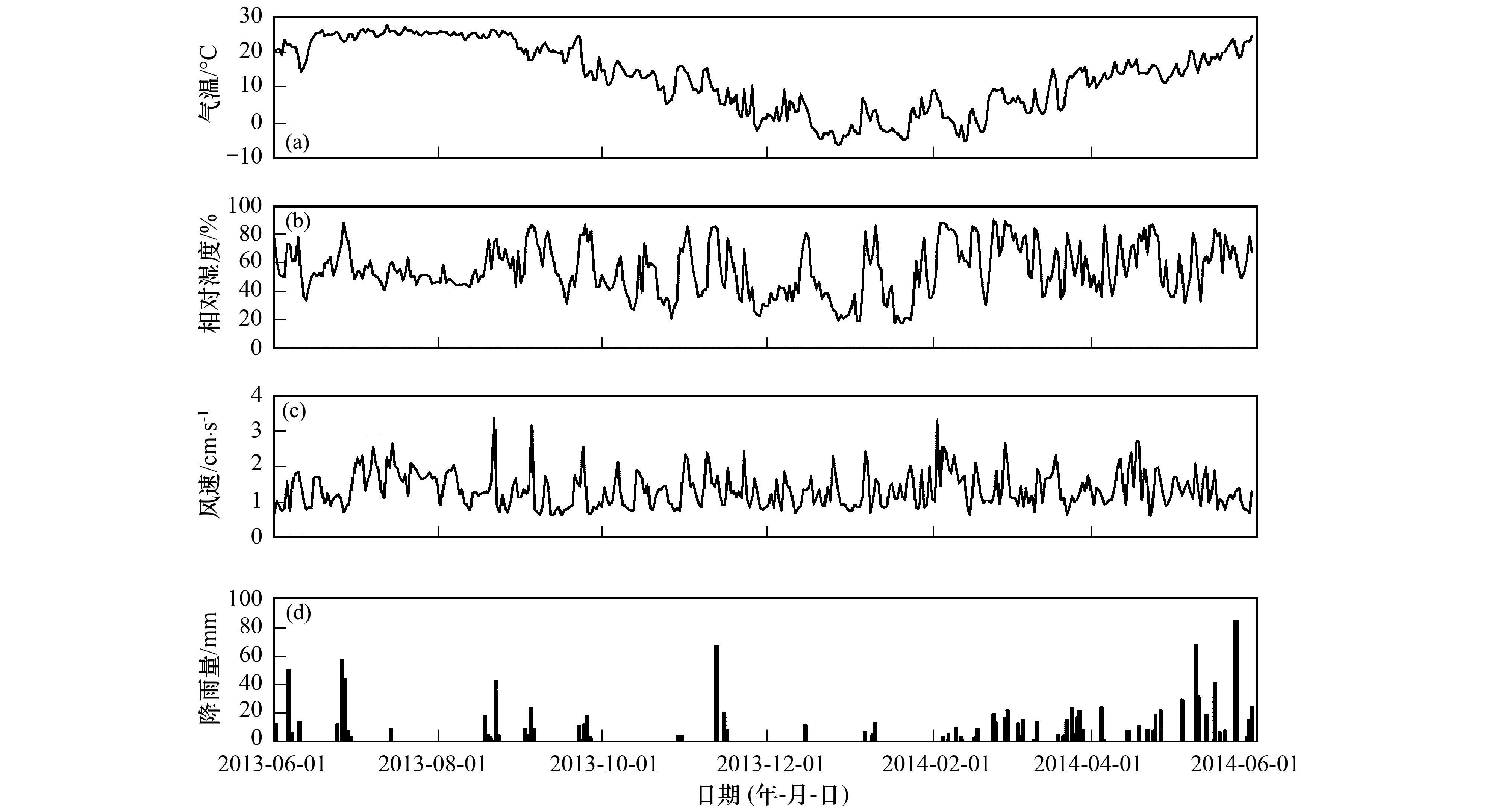
|
图 1 采样期间日平均气温、相对湿度、风速及降雨量 Fig. 1 Daily mean air temperature, relative humidity, wind speed and precipitation during the sampling period |
采样期间大气中NH3-N和NH4+-Np浓度(每10 d平均值)变化趋势见图 2.其中NH3-N浓度变化范围在0.4~28.8 μg·m-3, 平均浓度5.7 μg·m-3.从图 2中可以看出一年期间NH3浓度明显有两个高峰, 一个出现在早稻施基肥和追肥的4月下旬和5月上旬, 另一个出现在晚稻施基肥和追肥的7月中旬和下旬, 因此可认为两次峰值均是由稻田施肥后氨挥发引起的.休闲季(11月~次年3月)与水稻季相比NH3-N浓度相对较低, 平均浓度2.8 μg·m-3. NH4+-Np浓度在1.3~18.9 μg·m-3, 平均为9.3 μg·m-3, 6~10月浓度相对较低, 平均值为4.4 μg·m-3, 11月~次年5月浓度较高, 平均值12.8 μg·m-3.
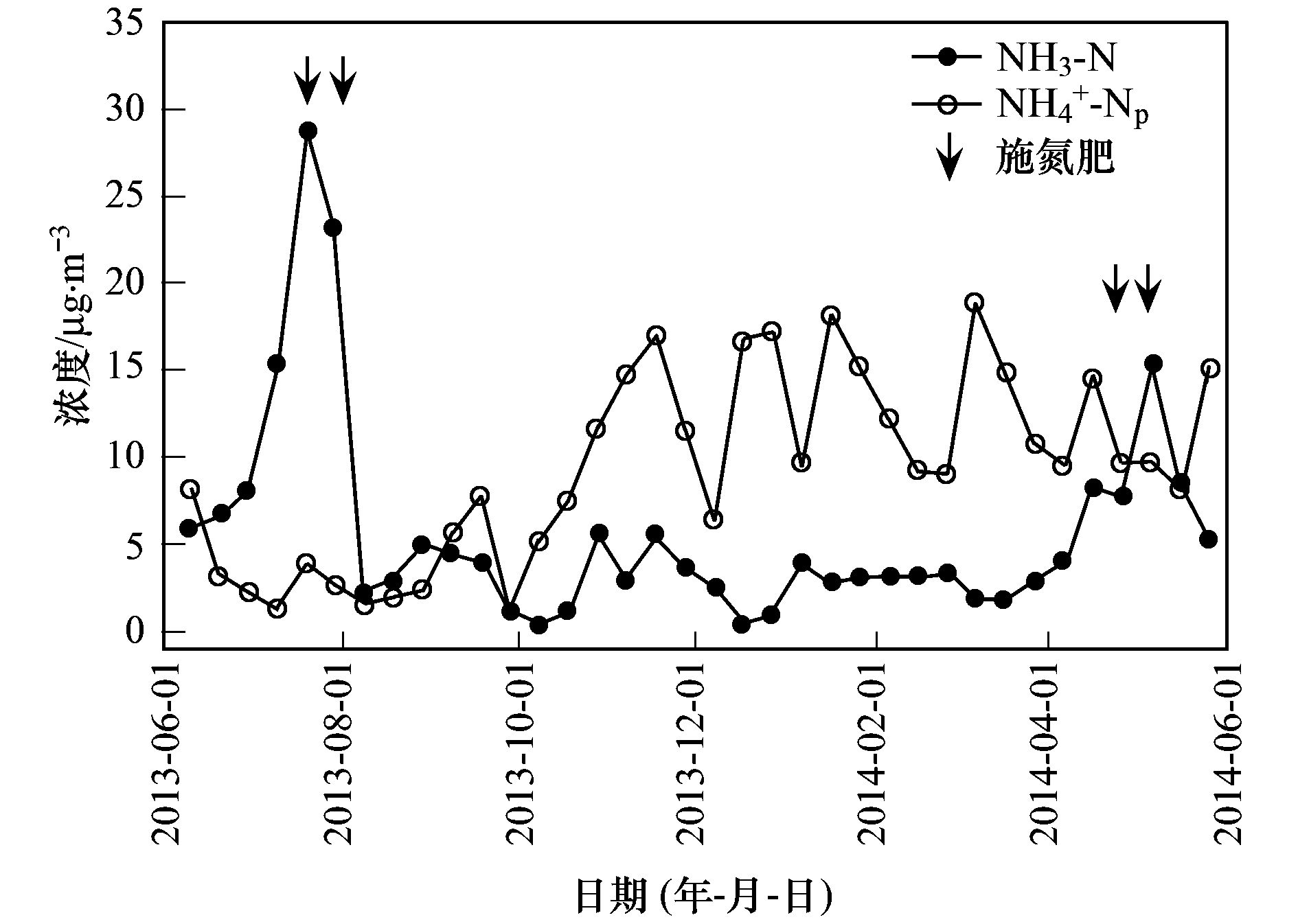
|
图 2 采样期间每10 d氨氮和颗粒态铵态氮平均浓度 Fig. 2 Mean NH3-N and particulate NH4+-N concentrations of every ten days during the sampling period |
采样期间, NH4+-Nr浓度变异较大, 变异范围在0.16~3.45 mg·L-1之间(图 3), 体积加权平均为0.77 mg·L-1.高浓度的NH4+-Nr主要出现在降雨量小的降雨事件, 低浓度的NH4+-Nr则主要出现在降雨量大的降雨事件. 75场雨中有10场NH4+-Nr浓度大于2 mg·L-1, 超国家Ⅴ类地表水标准.虽然降雨对NH4+-Nr浓度有一定的稀释作用, 但在降雨集中的春季, NH4+-Nr仍维持较高的浓度, 与春季较高的NH4+-Np浓度时间上同步.

|
图 3 采样期间每10 d雨水中铵态氮浓度及沉降量 Fig. 3 Mean NH4+-N concentration in rainwater and NH4+-N wet deposition of every ten days during the sampling period |
每10 d的NH4+-Nr沉降量变异也较大, 但要较NH4+-Nr浓度变化相对平缓, 其变异范围在0~0.83 kg·hm-2之间.受降雨量分布的影响, 湿沉降主要发生在春季, 其次为夏季、冬季, 秋季湿沉降最少.
2.4 影响各种铵态氮浓度的影响因素对NH3-N浓度、NH4+-Np浓度、NH4+-Nr浓度、NH4+-Nr湿沉降量和各气象因子(降雨量、温度、风速、相对湿度)之间进行了相关性分析(表 1). NH3-N浓度主要与气温成显著正相关, NH4+-Np浓度与气温成显著负相关, NH4+-Nr浓度主要与降雨量、气温成负相关, 湿沉降铵态氮则主要与降雨量成显著正相关.
|
|
表 1 NH3-N、NH4+-Np、NH4+-Nr浓度及其沉降量与气象因子相关性分析1) Table 1 Correlation analysis among NH3-N, particulate NH4+-N, rainwater NH4+-N concentrations and meteorological parameters |
2.5 氨氮、气溶胶态铵态氮和雨水中铵态氮季节平均浓度
3种大气氨/铵态氮组成的季节平均浓度各不相同(图 4). NH3-N浓度夏季最高, 其次为春季, 秋季和冬季浓度较低, 夏季和春季NH3-N平均浓度分别是冬季的4.5倍和3.1倍.而NH4+-Np浓度与NH3-N浓度相反, 冬季最高, 夏季最低. NH4+-Nr浓度无明显季节变化趋势, 浓度由高到低依次是冬季、春季、夏季、秋季.

|
图 4 氨氮、颗粒态铵态氮和雨水中铵态氮季节平均浓度 Fig. 4 Seasonal mean concentrations of NH3-N, particulate NH4+-N and rainwater NH4+-N |
图 5为不同形态的氨/铵态氮月沉降量.其中, NH4+-Nr一年总的湿沉降量为9.07 kg·(hm2·a)-1, 每月平均值为0.76 kg·(hm2·M)-1, 湿沉降量最多的月份为5月, 沉降量为2.00 kg·(hm2·M)-1, 最低的月份为12月, 沉降量为0.09 kg·(hm2·M)-1. NH3-N干沉降全年为8.38 kg·(hm2·a)-1, 月平均值为0.70 kg·(hm2·M)-1, 沉降最高月份为7月[2.74 kg·(hm2·M)-1], 最低月份为12月[0.12 kg·(hm2·M)-1]. NH4+-Np干沉降全年为5.61 kg·(hm2·a)-1, 沉降量最高月份为1月[0.68 kg·(hm2·M)-1], 最低的月份为8月[0.15 kg·(hm2·M)-1]. NH3-N和NH4+-Np总的干沉降量为14.0 kg·(hm2·a)-1.由图 6可以看出在不同的季节, 氨/铵态氮的主要沉降形式变化比较明显, 春季干湿沉降比例约各占一半, 其余季节主要以干沉降为主, 夏季主要以NH3-N沉降为主, 秋冬两季以NH4+-Np沉降贡献最大, 对总沉降的贡献均达到40%以上.
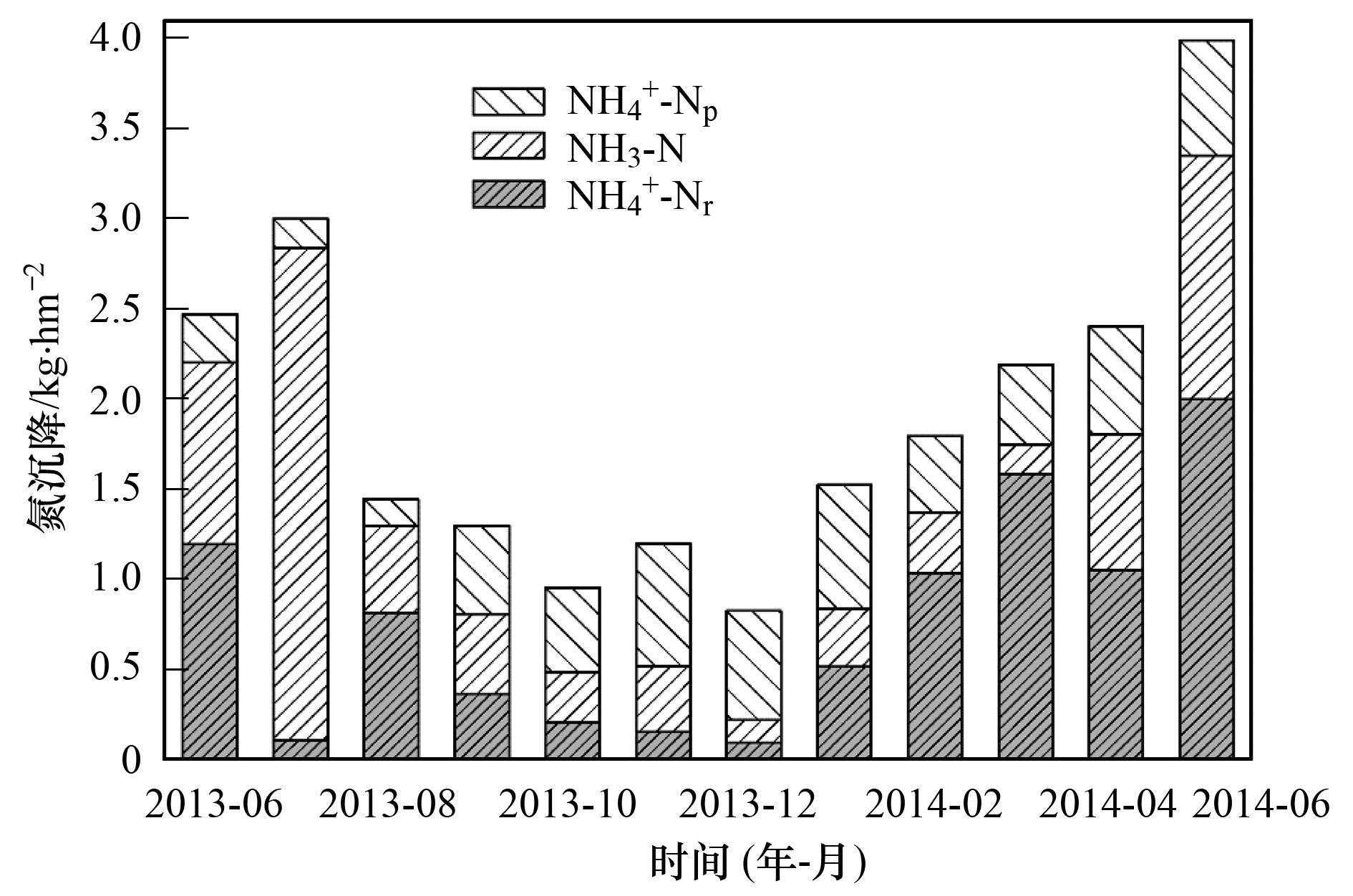
|
图 5 氨氮、颗粒态铵态氮和雨水中铵态氮月沉降量 Fig. 5 Monthly deposition rates of NH3-N, particulate NH4+-N and rainwater NH4+-N |
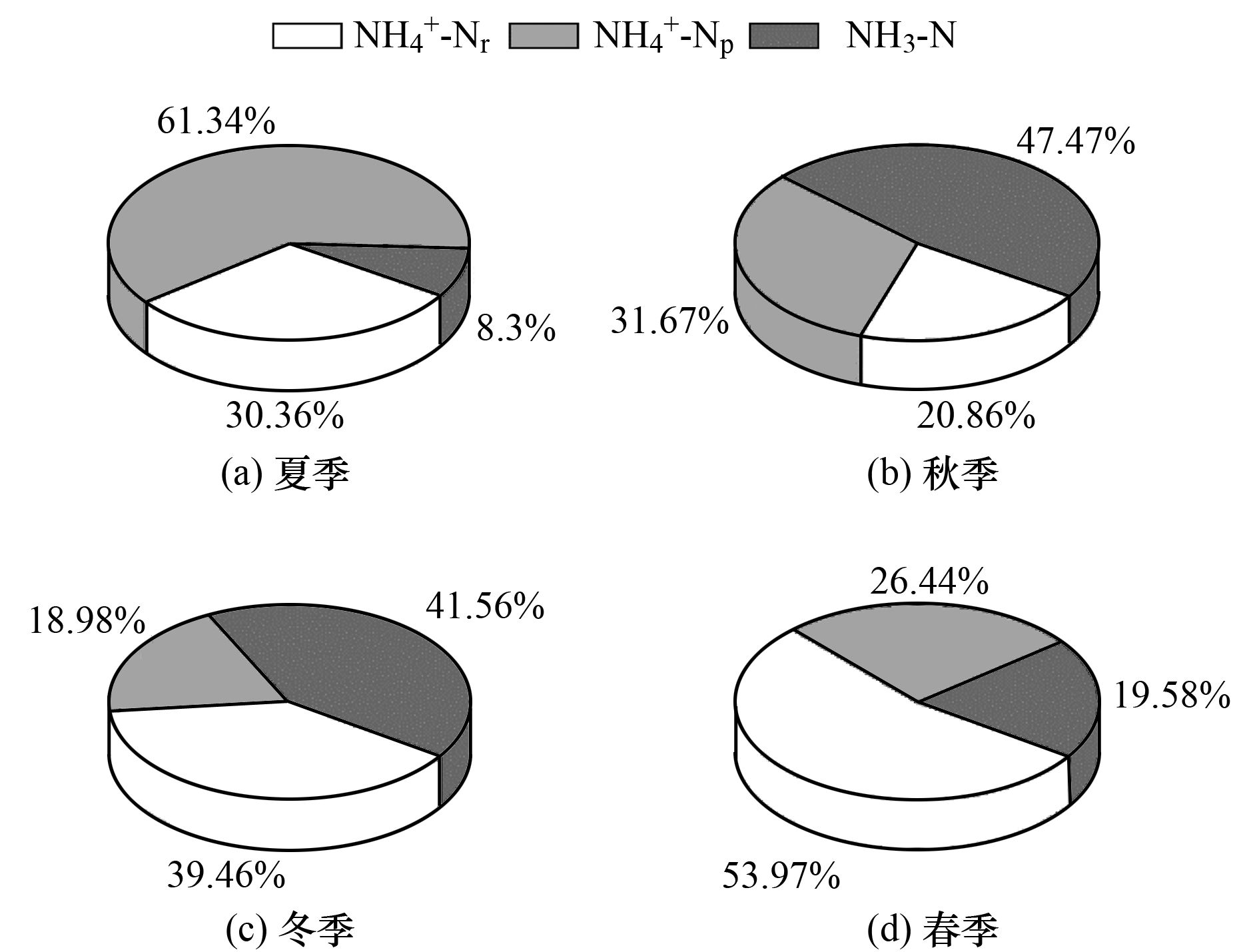
|
图 6 氨氮、颗粒态铵态氮和雨水中铵态氮沉降量季节比例 Fig. 6 Proportions of deposition rates of NH3-N, particulate NH4+-N and rainwater NH4+-N in the total NHx-N deposition in each season |
本研究结果表明亚热带稻区采样点具有较高的NH3-N、NH4+-Np和NH4+-Nr浓度.前人研究结果表明, 在自然、受人为活动干扰少的环境下, NH3-N浓度一般都较低, 通常在1 μg·m-3以下[19].在我国一些农区, 受高施肥量的影响, 大气中的NH3-N浓度均较高, 如华北平原、长三角平原、黄土高原、四川盆地等地[8, 20, 21].本研究结果也表明, 在氮肥施用后, NH3-N浓度出现峰值.这是因为当地施用的氮肥大多为尿素, 尿素水解过程中, 土壤pH上升, 土壤NH4+含量快速增加, 从而产生大量的氨挥发[22].且温度越高, 氨挥发量越大(表 1), 大气中NH3-N浓度也越高, 这也是晚稻季NH3-N浓度峰值要高于早稻季峰值的原因.前人研究结果表明, 稻田氮肥施用后的氨挥发损失可占到施氮量的10%~40%[22, 23].本研究中施肥主要发生在4月中下旬~5月上旬(早稻)、6月下旬~7月上旬(中稻)和7月中旬~7月下旬, 而氨挥发大多发生在施肥后的5~7 d内[24], 除去这些受施肥影响的时期, 监测点其他监测时期的NH3-N浓度相比于背景区NH3-N浓度仍较高.不施肥时期大气NH3-N浓度仍较高的原因可能有:一是受施氮肥的影响, 水稻冠层的NH3-N补偿点(指既不发生氨排放也不产生氨沉降时的冠层NH3-N浓度)仍较高, 当补偿点大于大气中NH3-N浓度时, 水稻能向大气中排放氨气, 从而提高大气NH3-N浓度[25, 26]; 二是外源(菜地施肥、畜禽粪便、生活垃圾等)的氨气输送也可使研究点NH3-N浓度上升[27].因此, 下一步研究有必要结合15N稳定同位素示踪技术[28]和风向资料[29]解析研究点NH3-N的来源.
研究人员对城市监测点的NH4+-Np浓度监测的结果表明, 目前我国许多大城市大气颗粒物PM10和PM2.5中都具有较高的铵态氮浓度[30, 31], 但有关农村采样点NH4+-Np浓度的报道还相对较少[32].本研究中所测的NH4+-Np浓度较高, 与一些城市监测点的结果[30, 31, 33]相当, 略低于文献[4, 20]报道的华北平原监测的结果.氨气是形成颗粒态铵的重要前体, 本研究中高的NH3-N浓度主要出现在春、夏季节, 而高的NH4+-Np浓度主要出现在秋、冬季节, NH3-N浓度与NH4+-Np浓度成一定负相关.因此, NH3-N浓度在本研究区域可能并不是形成NH4+-Np污染的主要限制因子, 气象因子、酸性气体等前体物质浓度对NH4+-Np浓度的影响可能更大.相关性分析表明(表 1), NH4+-Np浓度与气温成显著负相关, 表明低温有助于颗粒态铵态氮的形成.前人研究结果表明, 低温条件下受采暖活动的影响, 燃煤消耗量大, 排放到空气中的SO2、NOx增加, 有利于大气颗粒物生成, 加上冬季降雨量少不利于颗粒物的清除, 从而导致较高的NH4+-Np浓度[34].近期的研究结果表明, 控制SO2、NOx等前体物质的浓度对于控制大气颗粒物污染更有效果[35, 36].
本研究中较高的NH4+-Nr浓度, 与前人在亚热带区域报道的高的NH4+-Nr浓度较为一致[37, 38]. NH4+-Nr浓度主要与NH4+-Np浓度成正相关, 与降雨量、气温呈负相关(表 1).气温低时, 颗粒物浓度高, 云水中将凝聚较多的NH4+-Np, 而降雨进行云下清除的NH4+-Np也多, 从而增加NH4+-Nr浓度.降雨量大时, NH4+-Nr浓度被稀释, 从而使其浓度与降雨量成负相关.
本研究中氨/铵态氮的年干湿沉降总量达到23.1 kg·(hm2·a)-1, 表明氨/铵态氮沉降已经成为农田氮素的一个重要来源.在华北平原[16.3~43.2 kg·(hm2·a)-1][39]、黄土高原[5.7~23.2 kg·(hm2·a)-1][40]、长三角平原区[36.9 kg·(hm2·a)-1][41]、四川盆地[17.8 kg·(hm2·a)-1][38]农区均报道有较高的氨/铵态氮沉降, 表明我国农区当前大气氨/铵态氮污染比较严重, 会产生较高的氨/铵态氮大气沉降输入.根据本研究区域双季稻生产中平均年施氮量360 kg·hm-2计, 氨/铵态氮沉降占到肥料氮投入的6.2%.稻田化肥氮氨挥发比例一般在10%[22, 23]以上, 因此稻田仍是大气中氨/铵态氮的净排放源.本研究中高的氨/铵态氮沉降, 也将为稻田周边的杂草提供重要氮源, 可能是造成研究区农田周边杂草丛生的重要原因.
本研究采用阻力模式估算了大气NH3-N和NH4+-Np的干沉降速率.采样点NH3-N的月平均干沉降速率在0.34~0.60 cm·s-1之间, 平均为0.44 cm·s-1; NH4+-Np的月平均干沉降速率在0.16~0.33 cm·s-1之间, 平均为0.21 cm·s-1(图 7).本研究模拟的干沉降速率与前人报道的农田(麦地、玉米)NH3-N和NH4+-Np干沉降速率具有可比性[39, 42], 表明模拟结果有一定的可靠性.对于氨气, 其在地表-大气之间通常存在双向传输, 既有地表向大气的排放, 也有大气到地表的沉降.而这种排放-沉降之间的转换可能会发生在亚小时尺度、日尺度和季节尺度, 调控因子主要包括有植物叶片/土壤/凋落层氮营养状况、叶片湿度、叶片温度等[25].这种调控作用, 使得氨气在植物冠层高度存在一个补偿浓度(补偿点), 当大气中的NH3-N浓度高于冠层补偿点时, 氨气便由大气向地表沉降; 反之, 氨气则由地表向大气挥发[26].由于受研究手段的限制, 本研究未能测定氨气补偿点, 而是认为排放到大气的NH3-N时刻发生沉降, 因此可能对NH3-N沉降有所高估.为进一步校正模型结果, 今后有必要采用微气象学方法[43], 测定实地NH3-N和NH4+-Np的干沉降速率.
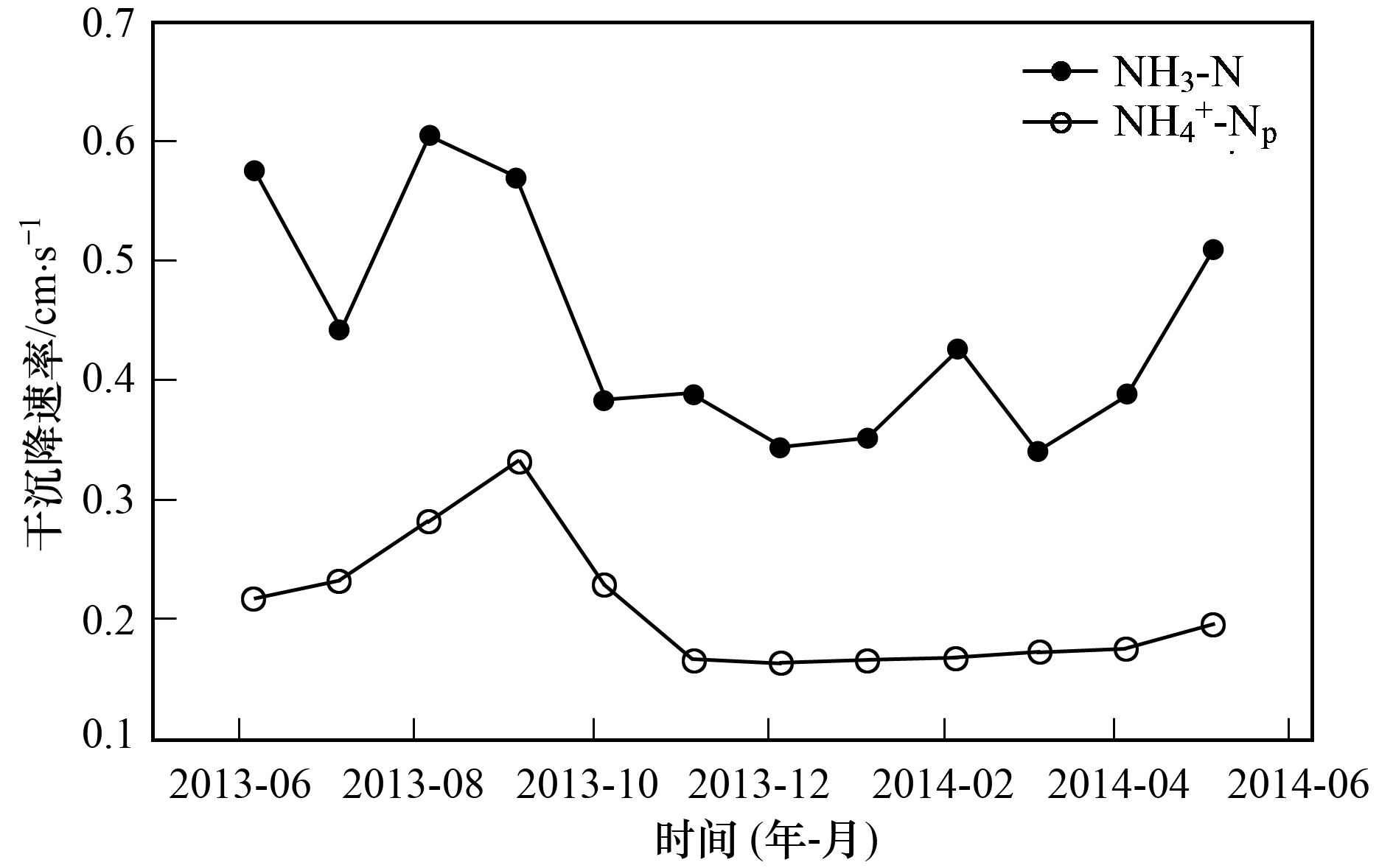
|
图 7 采样期间氨氮、颗粒态铵态氮干沉降速率 Fig. 7 Monthly mean dry deposition velocities of NH3-N and particulate NH4+-N during the sampling period |
(1) 在我国亚热带丘陵区的一个典型双季稻区监测结果表明, 大气中NH3-N、大气颗粒物PM10中NH4+-Np浓度以及NH4+-Nr年平均浓度分别为5.7 μg·m-3、12.8 μg·m-3和0.8 mg·L-1. NH3-N浓度为夏季和春季较高, 秋季和冬季较低; NH4+-Np浓度与NH3-N浓度相反, 冬季最高, 夏季最低; NH4+-Nr浓度以冬季最高, 秋季最低.
(2) 稻田施氮肥显著提高NH3-N浓度, 且NH3-N浓度与气温成显著正相关; NH4+-Np浓度与NH3-N浓度并未显著相关, 表明NH3-N浓度在本研究区域并不是形成NH4+-Np污染的主要限制因子; NH4+-Nr浓度主要与NH4+-Np浓度成正相关, 与降雨量成负相关.
(3) 本研究稻区的大气氨/铵态氮的年大气干湿沉降总量为23.1 kg·(hm2·a)-1, 是稻田的重要氮素来源.
| [1] | Skjøth C A, Geels C. The effect of climate and climate change on ammonia emissions in Europe[J]. Atmospheric Chemistry and Physics, 2013, 13(1): 117–128. DOI: 10.5194/acp-13-117-2013 |
| [2] | 尤翔宇, 刘湛, 张青梅, 等. 长株潭地区人为源氨排放清单及分布特征[J]. 环境科学, 2016, 37(1): 94–101. You X Y, Liu Z, Zhang Q M, et al. Anthropogenic ammonia emission inventory and its spatial distribution in Chang-Zhu-Tan region[J]. Environmental Science, 2016, 37(1): 94–101. |
| [3] | Aneja V P, Schlesinger W H, Erisman J W. Farming pollution[J]. Nature Geoscience, 2008, 1(7): 409–411. DOI: 10.1038/ngeo236 |
| [4] | Shen J L, Liu X J, Zhang Y, et al. Atmospheric ammonia and particulate ammonium from agricultural sources in the North China Plain[J]. Atmospheric Environment, 2011, 45(28): 5033–5041. DOI: 10.1016/j.atmosenv.2011.02.031 |
| [5] | Liu X J, Zhang Y, Han W X, et al. Enhanced nitrogen deposition over China[J]. Nature, 2013, 494(7438): 459–462. DOI: 10.1038/nature11917 |
| [6] | Shen J L, Li Y, Liu X J, et al. Atmospheric dry and wet nitrogen deposition on three contrasting land use types of an agricultural catchment in subtropical central China[J]. Atmospheric Environment, 2013, 67: 415–424. DOI: 10.1016/j.atmosenv.2012.10.068 |
| [7] | 顾峰雪, 黄玫, 张远东, 等. 1961-2010年中国区域氮沉降时空格局模拟研究[J]. 生态学报, 2016, 36(12): 3591–3600. Gu F X, Huang M, Zhang Y D, et al. Modeling the temporal-spatial patterns of atmospheric nitrogen deposition in China during 1961-2010[J]. Acta Ecologica Sinica, 2016, 36(12): 3591–3600. |
| [8] | Xu W, Luo X S, Pan Y P, et al. Quantifying atmospheric nitrogen deposition through a nationwide monitoring network across China[J]. Atmospheric Chemistry and Physics, 2015, 15(21): 12345–12360. DOI: 10.5194/acp-15-12345-2015 |
| [9] | Huang X, Song Y, Li M M, et al. A high-resolution ammonia emission inventory in China[J]. Global Biogeochemical Cycles, 2012, 26(1): GB1030. |
| [10] | 李名升, 任晓霞, 周磊, 等. 中国大气SO2污染与排放的空间分离分析[J]. 环境科学学报, 2013, 33(4): 1150–1157. Li M S, Ren X X, Zhou L, et al. Spatial mismatch between SO2 pollution and SO2 emission in China[J]. Acta Scientiae Circumstantiae, 2013, 33(4): 1150–1157. |
| [11] | Zhao B, Wang S X, Liu H, et al. NOx emissions in China:historical trends and future perspectives[J]. Atmospheric Chemistry and Physics, 2013, 13(19): 9869–9897. DOI: 10.5194/acp-13-9869-2013 |
| [12] | 郝卓, 高扬, 张进忠, 等. 南方红壤区氮湿沉降特征及其对流域氮输出的影响[J]. 环境科学, 2015, 36(5): 1630–1638. Hao Z, Gao Y, Zhang J Z, et al. Characteristics of atmospheric nitrogen wet deposition and associated impact on N transport in the watershed of red soil area in southern China[J]. Environmental Science, 2015, 36(5): 1630–1638. |
| [13] | 郭雅思, 于奭, 黎泳珊, 等. 桂林市酸雨变化特征及来源分析[J]. 环境科学, 2016, 37(8): 2897–2905. Gao Y S, Yu S, Li Y S, et al. Chemical characteristics and source of acid precipitation in Guilin[J]. Environmental Science, 2016, 37(8): 2897–2905. |
| [14] | Wesely M L, Hicks B B. Some factors that affect the deposition rates of sulfur dioxide and similar gases on vegetation[J]. Journal of the Air Pollution Control Association, 1977, 27(11): 1110–1116. DOI: 10.1080/00022470.1977.10470534 |
| [15] | Erisman J W, Draaijers G P J. Atmospheric deposition in relation to acidification and eutrophication[M]. Amsterdam: Elsevier, 1995: 1-404. |
| [16] | Wesely M L. Parameterization of surface resistances to gaseous dry deposition in regional-scale numerical models[J]. Atmospheric Environment, 1989, 23(6): 1293–1304. DOI: 10.1016/0004-6981(89)90153-4 |
| [17] | Slinn W G N. Predictions for particle deposition to vegetative canopies[J]. Atmospheric Environment, 1982, 16(7): 1785–1794. DOI: 10.1016/0004-6981(82)90271-2 |
| [18] | Zhang L M, Gong S L, Padro J B L, et al. A size-segregated particle dry deposition scheme for an atmospheric aerosol module[J]. Atmospheric Environment, 2001, 35(3): 549–560. DOI: 10.1016/S1352-2310(00)00326-5 |
| [19] | Chen X, Day D, Schichtel B, et al. Seasonal ambient ammonia and ammonium concentrations in a pilot IMPROVE NHx monitoring network in the western United States[J]. Atmospheric Environment, 2014, 91: 118–126. DOI: 10.1016/j.atmosenv.2014.03.058 |
| [20] | 孟昭阳, 谢育林, 贾诗卉, 等. 2013年夏季华北乡村站点固城大气氨变化特征[J]. 应用气象学报, 2015, 26(2): 141–150. Meng Z Y, Xie Y L, Jia S H, et al. Characteristics of atmospjeric ammonia at Gucjeng, a rural site on nortj cjina plain in summer of 2013[J]. Journal of Applied Meteorological Science, 2015, 26(2): 141–150. DOI: 10.11898/1001-7313.20150202 |
| [21] | Yang R, Hayashi K, Zhu B, et al. Atmospheric NH3 and NO2 concentration and nitrogen deposition in an agricultural catchment of Eastern China[J]. Science of The Total Environment, 2010, 408(20): 4624–4632. DOI: 10.1016/j.scitotenv.2010.06.006 |
| [22] | 田光明, 蔡祖聪, 曹金留, 等. 镇江丘陵区稻田化肥氮的氨挥发及其影响因素[J]. 土壤学报, 2001, 38(3): 324–332. Tian G M, Cai Z C, Cao J L, et al. Ammonia volatilization from paddy field and its affecting factors in Zhenjiang hilly region[J]. Acta Pedologica Sinica, 2001, 38(3): 324–332. |
| [23] | 朱兆良. 中国土壤氮素研究[J]. 土壤学报, 2008, 45(5): 778–783. Zhu Z L. Research on soil nitrogen in China[J]. Acta Pedologica Sinica, 2008, 45(5): 778–783. |
| [24] | 敖玉琴, 张维, 田玉华, 等. 脲胺氮肥对太湖地区稻田氨挥发及氮肥利用率的影响[J]. 土壤, 2016, 48(2): 248–253. Ao Y Q, Zhang W, Tian Y H, et al. Effects of urea-ammonium mixed nitrogen fertilizer on ammonia volatilization and nitrogen use efficiency in paddy field of Taihu lake region[J]. Soils, 2016, 48(2): 248–253. |
| [25] | Massad R S, Nemitz E, Sutton M A. Review and parameterisation of bi-directional ammonia exchange between vegetation and the atmosphere[J]. Atmospheric Chemistry and Physics, 2010, 10(21): 10359–10386. DOI: 10.5194/acp-10-10359-2010 |
| [26] | Sutton M A, Schjorring J K, Wyers G P, et al. Plant-atmosphere exchange of ammonia[and discussion][J]. Philosophical Transactions of the Royal Society A:Mathematical, Physical and Engineering Sciences, 1995, 351(1696): 261–278. DOI: 10.1098/rsta.1995.0033 |
| [27] | Shen J L, Chen D L, Bai M, et al. Ammonia deposition in the neighbourhood of an intensive cattle feedlot in Victoria, Australia[J]. Scientific Reports, 2016, 6: 32793. DOI: 10.1038/srep32793 |
| [28] | 谢志英, 肖化云, 朱仁果, 等. 利用石生苔藓氮含量与氮同位素探讨江西省大气氮沉降量和来源[J]. 环境科学, 2011, 32(4): 943–948. Xie Z Y, Xiao H Y, Zhu R G, et al. Nitrogen concentrations and stable isotope in epilithic mosses to investigate atmospheric N deposition and N sources in Jiangxi province[J]. Environmental Science, 2011, 32(4): 943–948. |
| [29] | Baek B H, Aneja V P, Tong Q S. Chemical coupling between ammonia, acid gases, and fine particles[J]. Environmental Pollution, 2004, 129(1): 89–98. DOI: 10.1016/j.envpol.2003.09.022 |
| [30] | 曹双, 吴丹, 陈利珍, 等. 中国大气气溶胶中水溶性离子的污染特征[J]. 环境科学与技术, 2016, 39(8): 103–115. Cao S, Wu D, Chen L Z, et al. Characteristics of water-soluble inorganic ions of aerosol in China:a review[J]. Environmental Science & Technology, 2016, 39(8): 103–115. |
| [31] | 张秋晨, 朱彬, 龚佃利. 南京地区大气气溶胶及水溶性无机离子特征分析[J]. 中国环境科学, 2014, 34(2): 311–316. Zhang Q C, Zhu B, Gong D L. Characterization of water-soluble ion species of aerosol in Nanjing, China[J]. China Environmental Science, 2014, 34(2): 311–316. |
| [32] | 陈仕意, 曾立民, 董华斌, 等. 华北地区乡村站点(曲周)夏季PM2.5中二次无机组分的生成机制与来源解析[J]. 环境科学, 2015, 36(10): 3554–3565. Chen S Y, Zeng L M, Dong H B, et al. Transformation mechanism and sources of secondary inorganic components in PM2.5 at an agriculture site (Quzhou) in the North China Plain in summer[J]. Environmental Science, 2015, 36(10): 3554–3565. |
| [33] | 杨懂艳, 刘保献, 张大伟, 等. 2012~2013年间北京市PM2.5中水溶性离子时空分布规律及相关性分析[J]. 环境科学, 2015, 36(3): 768–773. Yang D Y, Liu B X, Zhang D W, et al. Correlation, seasonal and temporal variation of water-soluble ions of PM2.5in Beijing during 2012-2013[J]. Environmental Science, 2015, 36(3): 768–773. |
| [34] | 严文莲, 周德平, 王扬峰, 等. 沈阳冬夏季可吸入颗粒物浓度及尺度谱分布特征[J]. 应用气象学报, 2008, 19(4): 435–443. Yan W L, Zhou D P, Wang Y F, et al. Concentrations and size distributions of inhalable particles in summer and winter in Shenyang[J]. Journal of Applied Meteorological Science, 2008, 19(4): 435–443. |
| [35] | Pan Y P, Wang Y S, Zhang J K, et al. Redefining the importance of nitrate during haze pollution to help optimize an emission control strategy[J]. Atmospheric Environment, 2016, 141: 197–202. DOI: 10.1016/j.atmosenv.2016.06.035 |
| [36] | Cheng Y F, Zheng G J, Wei C, et al. Reactive nitrogen chemistry in aerosol water as a source of sulfate during haze events in China[J]. e1601530, 2016, 2(12). |
| [37] | Cui J, Zhou J, Peng Y, et al. Atmospheric wet deposition of nitrogen and sulfur to a typical red soil agroecosystem in Southeast China during the ten-year monsoon seasons (2003-2012)[J]. Atmospheric Environment, 2014, 82: 121–129. DOI: 10.1016/j.atmosenv.2013.10.023 |
| [38] | Kuang F H, Liu X J, Zhu B, et al. Wet and dry nitrogen deposition in the central Sichuan Basin of China[J]. Atmospheric Environment, 2016, 143: 39–50. DOI: 10.1016/j.atmosenv.2016.08.032 |
| [39] | Luo X S, Liu P, Tang A H, et al. An evaluation of atmospheric Nr pollution and deposition in North China after the Beijing Olympics[J]. Atmospheric Environment, 2013, 74: 209–216. DOI: 10.1016/j.atmosenv.2013.03.054 |
| [40] | Liang T, Tong Y A, Xu W, et al. Atmospheric nitrogen deposition in the Loess area of China[J]. Atmospheric Pollution Research, 2016, 7(3): 447–453. DOI: 10.1016/j.apr.2015.11.001 |
| [41] | 孙丽英. 南京地区大气氮磷沉降及模拟氮沉降对土壤气体排放的影响研究[D]. 南京: 南京农业大学, 2014. 50-56. Sun L Y. Atmospheric nitrogen and phosphorus deposition in Nanjing and effects of simulated nitrogen deposition on gaseous emissions of soils[D]. Nanjing:Nanjing Agricultural University, 2014. 50-56. |
| [42] | Flechard C R, Nemitz E, Smith R I, et al. Dry deposition of reactive nitrogen to European ecosystems:a comparison of inferential models across the Nitro Europe network[J]. Atmospheric Chemistry and Physics, 2011, 11(6): 2703–2728. DOI: 10.5194/acp-11-2703-2011 |
| [43] | Lee X. On micrometeorological observations of surface-air exchange over tall vegetation[J]. Agricultural and Forest Meteorology, 1998, 91(1-2): 39–49. DOI: 10.1016/S0168-1923(98)00071-9 |
 2017, Vol. 38
2017, Vol. 38


